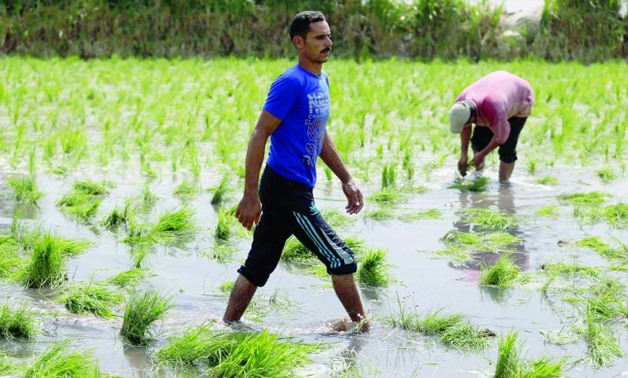
FILE- Limited resources. Farmers transplant rice seedlings in a paddy field in Qalyub in Egypt’s El-Kalubia governorate - REUTERS
CAIRO – 6 September 2019: Despite decisions of reducing the rice-planted areas nationwide due to the water shortage crisis that the county faces, the government has increased the areas of lands to be used in rice cultivation in 2019.
Head of the Rice Division in the Federation of Egyptian Industries (FEI) Rajab Shehata told the state-owned news agency MENA that the current rice-cultivating season started on September 1 after increasing the cultivated areas this year.
He added that the would-be cultivated area increased to 1.2 million acres compared to 724,000 acres to meet people’s needs.
In April 2018, Egypt's Parliament passed a law banning the cultivation of some crops that require a large amount of water, amid fears that building the Grand Ethiopian Renaissance Dam (GERD) would cut the country's share of the Nile. The Parliament also approved the government's request to amend some provisions in Agriculture Law No. 53 of 1966.
Article 1 of the Agriculture Law stipulates that the minister of agriculture, in coordination with the minister of irrigation, shall issue a ministerial decree to ban the cultivation of some crops in certain areas that have low amounts of water in order to rationalize water usage.
Egypt depends entirely on the Nile water for drinking and irrigation purposes, reiterating consistently its "historical right" to the river guaranteed in the 1929 and 1959 Nile agreements, which granted the country 87 percent of the Nile water and the right to veto or approve irrigation projects in the upstream countries.
Egypt annually needs at least 105 billion cubic meters of water to cover the needs of more than 90 million citizens. However, it currently has only 60 billion cubic meters, of which 55.5 billion cubic meters come from the Nile and just less than 5 billion cubic meters coming from non-renewable subterranean water in the desert. The remaining 80 billion cubic meters are covered by the reuse of wastewater

Comments
Leave a Comment